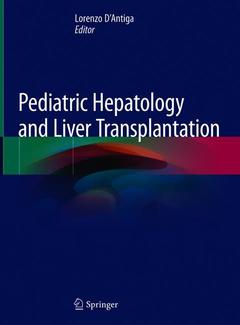Pediatric Hepatology and Liver Transplantation, 1st ed. 2019
Coordonnateur : D'Antiga Lorenzo

Chapter 1: Liver disease in paediatric medicine: An overview.- Chapter 2: Anatomy and histology of the liver and biliary tract.- Chapter 3: Laboratory evaluation of hepatobiliary disease.- Chapter 4: Diagnostic and interventional radiology.- Chapter 5: Practical approach to the jaundiced infant.- Chapter 6: Biliary atresia and other disorders of the extrahepatic biliary tree.- Chapter 7: Acute liver failure.- Chapter 8: Viral hepatitis.- Chapter 9: Autoimmune liver disease.- Chapter 10: Fibrocystic liver disease.- Chapter 11: Gallstone disease.- Chapter 12: Genetic and familial cholestasis.- Chapter 13: Wilson disease.- Chapter 14: Liver disease in cystic fibrosis.- Chapter 15: Inherited metabolic disorders.- Chapter 16: Non-alcoholic fatty liver disease and steatohepatitis in children.- Chapter 17: Complications of cirrhosis.- Chapter 18: Cirrhotic and non-cirrhotic portal hypertension.- Chapter 19: Vascular liver disease.- Chapter 20: Liver tumours and nodular lesions.- Chapter 21: The liver in systemic illness.-Chapter 22: Nutrition and liver disease.-Chapter 23: Intensive care management of the child with liver disease.- Chapter 24: Peculiarities of common and uncommon indications to liver transplantation.- Chapter 25: Organs availability and allocation.- Chapter 26: Surgical Techniques.- Chapter 27: Living donor liver transplantation.- Chapter 28: Listing for transplantation, postoperative management and f/up protocol.- Chapter 29: Surgical complications.- Chapter 30: Immunosuppression in paediatric liver transplantation.- Chapter 31: Pathology of liver allograft dysfunction.- Chapter 32: Chronic rejection and late allograft hepatitis.- Chapter 33: CMV and EBV infection and disease.- Chapter 34: Liver transplantation for inborn errors of metabolism.- Chapter 35: Immune tolerance following liver transplantation.- Chapter 36: Long-term outcome and transition to adult care.- Chapter 37: Neurodevelopment and Health Related Quality of Life of the Transplanted Child.- Chapter 38: Pediatric Liver Disease In Latin America.- Chapter 39: Liver disease in the African continent.- Chapter 40: Liver disease in the Asian continent.- Chapter 41: Next generation sequencing for the diagnosis of monogenic liver disease.- Chapter 42: Cell therapy for acute and chronic liver disease.- Chapter 43: Gene therapy in paediatric liver disease.
Lorenzo D’Antiga is a paediatric Hepatologist and Gastroenterologist working in Italy. His current position is Director of Child Health and of the Paediatric Liver, GI and Transplantation Unit of the Hospital Papa Giovanni XXIII of Bergamo. He trained as a paediatrician at the University of Padua and as a Paediatric Hepatologist in the United Kingdom, at King’s College Hospital London. He has worked as Consultant Gastroenterologist and Hepatologist as well as Paediatric Intensivist, specializing in organ failure and transplantation. ESPGHAN member for 15 years, he contributed to the field of paediatric hepatology with publications, scientific presentation and invited lectures. He has been member of the Council of the ESPGHAN as Education Secretary (till 2014) and member of the Education Committee of the UEG (till 2014). He serves as Senior Associate Editor for Journal of Pediatric Gastroenterology and Nutrition, and as Associate Editor of Liver Transplantation.
Offers concise, balanced examination of pediatric liver disease and liver transplantation
Features a reader-friendly, uniform structure of high practical and educational value
Meets the needs of both residents new to the field and specialists in transplantation centers
Date de parution : 05-2019
Ouvrage de 829 p.
21x27.9 cm
Disponible chez l'éditeur (délai d'approvisionnement : 15 jours).
Prix indicatif 210,99 €
Ajouter au panier


